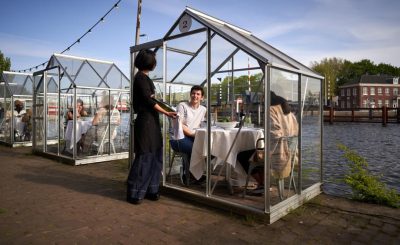After COVID-19 … what will the hospitality industry look like? Many can speculate on what changes may come from the global impact of this event. We will share the thoughts of those that challenge us to think BEYOND COVID-19.
Here’s your room-by-room look at the future
The Redefined Hotel – post Covid – Kimball Hospitality
Preparing Hotel for Employee Reentry – Kimball Hospitality
May 3, 2020
Byron Mühlberg
with reporting by Jamie de Geir & Zack Newmark
The Amsterdam restaurant using individual greenhouses for social distancing
With Dutch restaurants, bars and other catering services engulfed in uncertainty over how they might adjust to the 1.5-meter society, one Amsterdam restaurant is set to experiment with a brand new way of condoning off its guests: Using enclosed greenhouses.
 Mediamatic ETEN, part of a larger arts and entrepreneurship center focusing on sustainability, is a vegan restaurant located on the Dijksgracht in the Oosterdok neighborhood of Amsterdam. From May 21, the restaurant will begin taking in guests, only this time they will be seated inside Serres Séparées (‘separated greenhouses’), enclosed glass structures each equipped with a table for two or three diners.
Mediamatic ETEN, part of a larger arts and entrepreneurship center focusing on sustainability, is a vegan restaurant located on the Dijksgracht in the Oosterdok neighborhood of Amsterdam. From May 21, the restaurant will begin taking in guests, only this time they will be seated inside Serres Séparées (‘separated greenhouses’), enclosed glass structures each equipped with a table for two or three diners.
“This was one of the most feasible ideas from a large list of ideas we had when brainstorming,” Mediamatic’s founding partner Willem Velthoven told NL Times, pointing out that the public reception has so far been enthusiastic. “We only had tickets for June and the last week of May online and they are now all sold out,” he said.
Initially, no more than three guests will be allowed to dine inside each greenhouse, even though there is the capacity for more. “[This is] is because we are now careful with our optimism,” Velthoven explained.
“We have other, bigger greenhouses, but using them depends on how everything ends up going. Bigger  groups could [come] now but then they should be families. For now, bigger groups are being discouraged because, from our experience, they are just louder and then you get the excited behavior causing spittle to fly and so on, and that’s the kind of behavior that would make the virus spread faster,” Velthoven said.
groups could [come] now but then they should be families. For now, bigger groups are being discouraged because, from our experience, they are just louder and then you get the excited behavior causing spittle to fly and so on, and that’s the kind of behavior that would make the virus spread faster,” Velthoven said.
As restaurants and bars across the Netherlands begin deliberating on ways to reopen, many different proposals have come to the fore. Catering industry association KHN told NL Times, “We sent a protocol to the government two weeks ago, containing advice on how best to open the 1.5 distance. It is crucial that the government provide perspective quickly.”
While KHN said it would not yet advise restaurants to reopen on June 1, renowned catering tycoon Laurens Meyer told AD last week that restaurants and bars ought to begin taking steps as soon as possible to reopen, in order to support people whose livelihoods depend on the catering industry.
While Meyer expressed support for the industry’s adherence to the 1.5 society, he nonetheless questioned the idea of people becoming too careful with space.
 “We have to realize that there will always be some kind of virus. Whether it is worse than the flu, we have to see. If there is nothing left of our economy, we will no longer be able to afford health care and that will also cost human lives,” explained Meyer.
“We have to realize that there will always be some kind of virus. Whether it is worse than the flu, we have to see. If there is nothing left of our economy, we will no longer be able to afford health care and that will also cost human lives,” explained Meyer.
Velthoven, on the other hand, disagrees with Meyer’s approach, urging caution before advising restaurants to to open their doors to the public without careful examination. “It’s about others and not just yourself in this case,” he said.
He was also critical of a proposal floated last week by Amsterdam nightclub owners who wanted to open their doors to people under 30 years of age. “But those people can still spread the virus. I think if you say that you haven’t thought about it clearly, or you are just an irresponsible person.”
Velthoven also understands the business argument, even though he has spent a career looking for creative solutions to problems instead of blunt responses. He ultimately wondered what the government’s plan is for the catering sector if those businesses are ordered to stay closed for a longer duration. If billions of euros are being diverted to KLM, he wonders what the government will be able to do to bail out his industry.
“If I am not allowed to do anything the rest of this year, it’s finished,” he lamented.
New Processes of Hybridization of the Spaces of Hospitality and Work
What US hotel recovery could look like after COVID-19
 April 8, 2020
April 8, 2020
Winnipeg, Manitoba, Canada
Aaron Pollock, Architect, Number TEN Architectural Group
Hands on Approach to Hands Free Design
Now more than ever, we are hesitant to touch public surfaces. Whatever your new technique might be; like using your elbow to say hello, a disinfectant wipe to clean your grocery cart, or pulling your sleeve over your hand to open a door – we’re all guilty of doing something that just three weeks ago others would look at admonishingly.
Today, it is inspiring to see so many people taking this pandemic seriously as we all need to be doing our part in taking care of ourselves and one another. At Number TEN we are also taking this duty seriously and are developing thoughts on necessary design solutions to create safer and healthier spaces.
“necessary design solutions to create
safer and healthier spaces”
We challenged ourselves to think about these daily touch points and how we might use them differently. The elevator button, door pulls, fridge handle, even the coffee machine all now have this invisible layer of ‘goo’ that we’re hesitant to touch and try to disinfect daily (if not more). Using the office as our laboratory – we thought about how we might interact with these contact points differently. Not because we are germophobes or are avoiding essential hand-washing – but as an experiment in how we as designers rethink how we touch common surfaces in our spaces.

Controlling the door swing with your foot
while freeing up your hands to be full off
papers and cup of coffee
We all fundamentally know how to touch an elevator button or pull a door handle, but do we inherently know how to use them if we’re trying to avoid touching them? Using rapid prototyping, we set the task of designing and 3D printing armatures that liberate typical touch points in our office to become “hands-free.” We’ve all tried to open doors while our hands are full, so perhaps this exercise can aid in designing applications for hands-free living. Everything cannot be equipped with a sensor and operator, so which part of our bodies can be the next best dexterous to open, close and otherwise function as typical as possible.

Cabinet pulls had the most limitations in terms
of their various heights and locations and require
users to put their forearms to work.
The meeting room doors was one of the first obstacles. Large fully glazed doors equipped with long pulls, the most logistical solution was to somehow use our feet to give the ability to open and close the doors. The angled armature friction clips to the base of the door and allows the user to grip with the base of their shoes to swing the door open and closed. The hardware pulls in the café were another commonly touched surface in the office and required us to think about how an armature would work in both lower and upper cabinet conditions. Like the meeting room doors, the armature is designed to swing the doors open and closed, this time using the forearm. The initial pull takes the most force as the drawers and upper cabinets continue to slide with ease using the forearm – though with less control. Lastly and possibly the most touched surface in the office: the elevator button. These buttons as with most are small and flush with the wall. The armature is designed to allow the elbow or forearm to hit a larger pad that in turn presses the buttons beyond. In all circumstances we imagined ourselves as doctors scrubbed for surgery and navigating their way through day-to-day activities – all without being able to touch a public surface.

Elevator buttons likely see the most contact through
a given day. The armature is meant to be used by an
elbow or forearm to activate the buttons beyond.
These prototypes were printed by Richard Cueto, a technician and technology guru with Number TEN. Richard prepared and printed these armatures on his very own Ender 3 Pro 3D printer from home, using PLA or polylactic acid, a vegetable based plastic material. When he is not helping us rapid prototype ideas and models in the office, he is currently being an amazing humanitarian by 3D printing PPE (personal protective equipment) for hospitals and medical staff in need during the Covid-19 pandemic. If you have the ability, we challenge you to also help contribute where it is needed!
IMAGE 4
3D printed visor equipped with plastic shield that took 60 mins to print.
I feel as though we need to provide a disclaimer that this was just a very quick schematic exercise that perhaps posed more questions than solutions. Beyond looking a little silly and unconventional, the exercise explores how this pandemic will inevitably change the way we interact with our public spaces.
How about you the reader – yes, you who uses their sleeves to open doors. Have you come across a similar scenario in public where some sort of armature would have benefitted you to get around while avoid touching surfaces?
Aaron Pollock is an Architect with Number Ten Architectural Group.
UNDER GLASS: Brainstorming post Coronavirus
